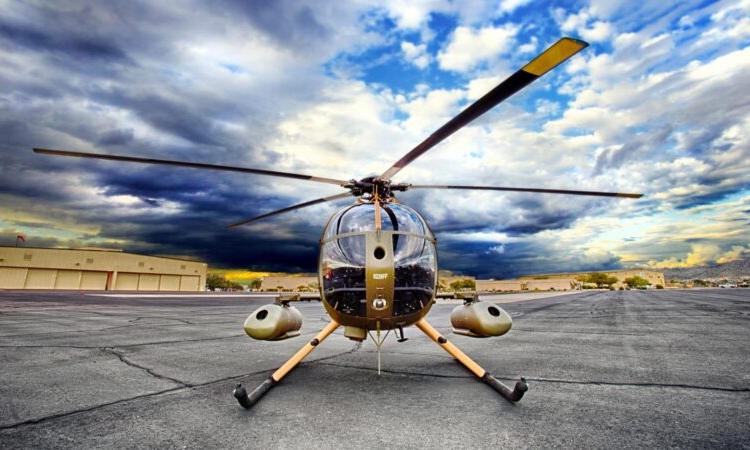Nigeria has selected the MD Helicopters (MDH) MD 530F Cayuse Warrior Plus (CWP) light attack helicopter, which was announced on 7 March. The Army ordered another 12 sets of the attack helicopter after it had initially ordered 24 of such from the US-based company to be deployed against insurgency.
The Arizona-based company said it is to supply 12 CWP helicopters to the Nigerian Army “to assist in counter-insurgency and counter-terrorism operations”. MDH did not disclose a contract value or delivery timeline. Nigeria plans to use the aircraft for area security, tactical reconnaissance, convoy escort, and drug interdiction missions.
MD Helicopters is expanding its production line to fulfil a Nigerian Army order for 12 Cayuse Warrior Plus scout/attack helicopters. MD Helicopters (MDH) said it is scaling up production line capacity and increasing staffing as additional sales orders come in for the company.
MDH said it has restructured its production facility and is planning to hire 120 more employees to support the production of the new aircraft.
This will allow the company to deal with additional, larger orders, as well as to engage with potential customers.
‘MD Helicopters has streamlined our production processes to directly address the current and planned increase of aircraft orders,’ MDH president and CEO Brad Pedersen noted in a statement.
Previously referred to as the MD 530F+, the CWP standard features a number of enhancements and modifications over the baseline MD 530F Cayuse Warrior in terms of armour, avionics, sensors, weapons systems, and increased power performance. The latest version of the Cayuse Warrior light-single, the Plus model adds guided rockets to the platform, alongside unguided rockets, podded machine guns and miniguns, integrated with a Moog weapons management system and chin-mounted L3Harris Wescam MX-10D electro-optical sensor.
Specifically, these comprise built-in ballistic tolerance in the structure from early stage in manufacturing, and a different avionics package supporting the Moog weapons management system. It features the Wescam MX-10D sensor turret, and can carry unguided and guided rockets, and gun pods (though not presently guided missiles).
The Cayuse Warrior Plus mounts an under-nose L3Harris Wescam MX-10D sensor turret that enables the use of precision-guided weapons such as the AGM-114 Hellfire missile and APKWS (Advanced Precision Kill Weapons System) guided rockets.
The CWP is based on the MD 530F Cayuse Warrior that in its military guise has been sold to date to Afghanistan, Kenya, and Saudi Arabia. Lebanon has also acquired the MD 530F+, while separately Malaysia has acquired the MD 530G, which MDH is no longer focused on marketing.
Specifications earlier released by MDH give the MD 530F-series a maximum gross weight of 1,700 kg, a useful load of 780 kg, a service ceiling of 16,000 ft, a hover-in-ground effect of 14,400 ft, a hover-out-of-ground effect of 14,000 ft, a range of 574 km, and a maximum cruise speed of 110 kt.
The deal also includes a complete support package, spares, pilot and groundcrew training, and a flight training device. Brad Pedersen, MD Helicopters chief executive, speaking ahead of the Heli-Expo show in Atlanta, sees strong potential for future sales of the MD530F-derived platform as a “competitively priced” alternative to more complex armed rotorcraft.
That even extends to the Boeing AH-6i Little Bird – a heavier and more capable version of the same aircraft – for which MD Helicopters supplies parts.
In 2020, the Nigerian Army announced its intentions to acquire combat helicopters to support and provide rapidly deployable firepower to its field-deployed troops in the northeastern area. Subsequently, Nigeria conducted negotiations with the European manufacturer Airbus, India’s HAL, and Turkish TAI.
The purchase is part of Abuja’s efforts to significantly enhance the Nigerian armed forces’ capacity to help tackle the threats posed by Islamic insurgent groups. The Nigerian Army blamed the lack of air power as the reason for the prolonged battle with the Boko Haram insurgents. The service also opined that it needs its own ‘air force’ to quickly wrap up the long-drawn military campaign.
Insurgent groups such as Boko Haram and Islamic State West Africa (ISWA) have managed to gain control of significant ungoverned areas in the country’s north over the last decade, as well as carrying out attacks and kidnappings across Nigeria. The country’s Army and Air Force have been recapitalized with new aircraft and equipment, while other programs have aimed to boost the armed forces’ professionalism.
Earlier last year, the Nigerian Army signed a contract with HAL which covers Phase-II flying training on Chetak Helicopter for six officers of the newly formed Nigerian Army Aviation.
India’s Hindustan Aeronautics Limited (HAL) signed a contract with the Nigerian Army to train six officers for basic helicopter flying training phase-I at the Rotary Wing Academy (RWA), Bengaluru.
Turkish TAI offered the T-129 ATAK helicopter. The unit price of the T-129 helicopter is $45 million,
In 2021 the Adjutant General of California National Guard, Maj.-Gen. David Baldwin, pledged to support the Nigerian Army to actualise the establishment of its aviation unit. Baldwin made the pledge when he led his team on courtesy visit to Army Headquarters on Tuesday in Abuja.
Furthermore, the Nigerian Army partnered with the French Army light aviation French Army Light Aviation (French: Aviation légère de l’armée de Terre, ALAT).
Nigeria is also planning to purchase 12 American AH-1 Cobra attack helicopters as part of an $875 million arms deal. Nigeria indicated an interest in buying surplus Bell AH-1 Cobra attack helicopters that were phased out of service by the Israeli air force in 2013.
The Nigerian Army will receive three MF-212 ISR and attack aircraft, as well as three Bell UH-1D transport helicopters, while AAI Corp., a subsidiary of Textron Systems, has confirmed the delivery of its Aerosonde unmanned aerial system (UAS) for the Nigerian Army.





